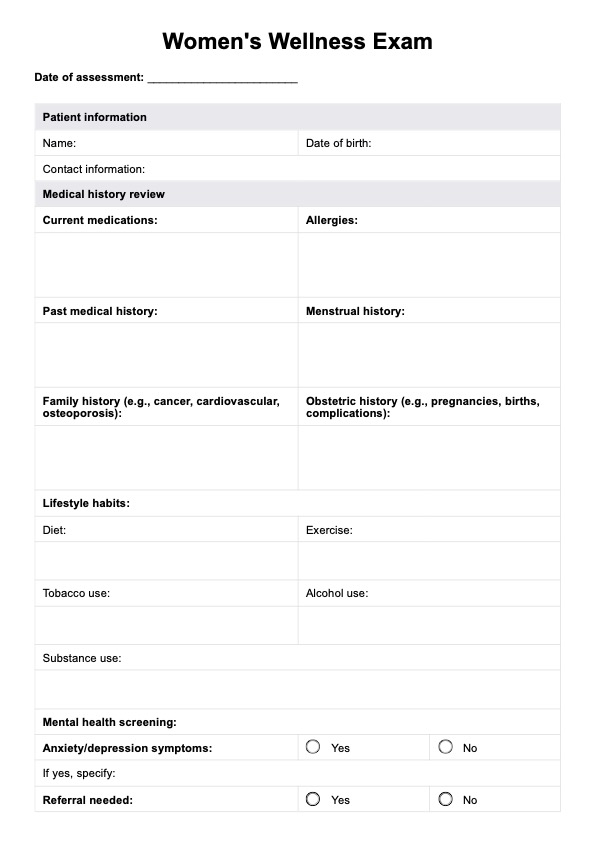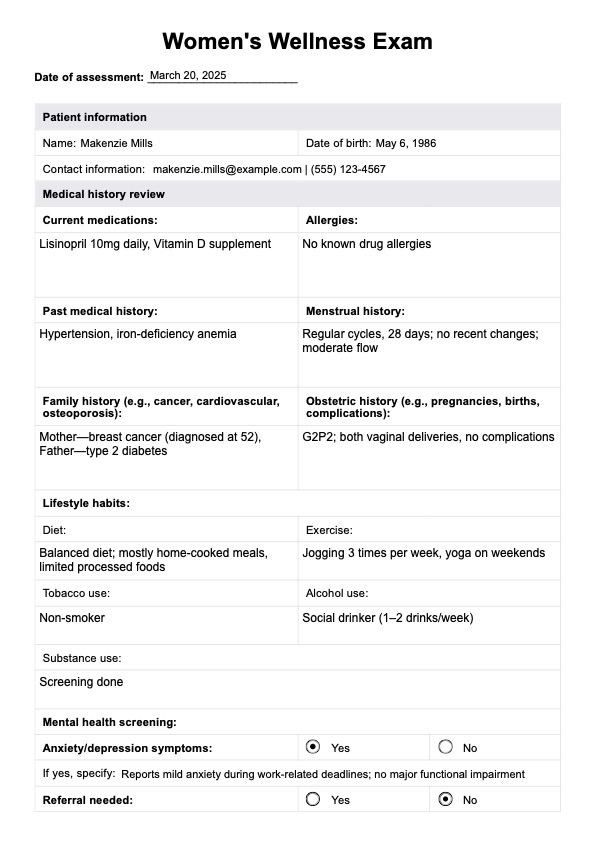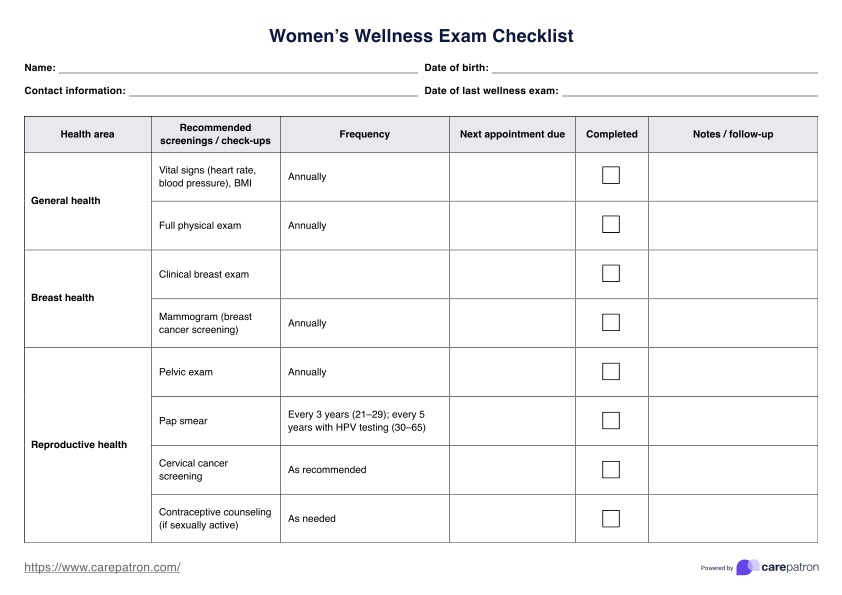Women's Wellness Exam
Enhance your women's healthcare practice with our Women's Wellness Exam Template - download now for a comprehensive guide to patient-centered care!


What is a Women's Wellness Exam Checklist?
The Women's Wellness Exam Checklist is an essential framework for clinical preventive health services, curated explicitly for women. It is a meticulously structured inventory that healthcare professionals utilize to thoroughly evaluate a woman's overall health status during routine check-ups or wellness visits. The checklist is instrumental in guiding the examination process, ensuring no critical aspect of a woman's health is overlooked.
This resource typically covers the following key health domains:
- General health: Vital signs like heart rate, blood pressure screening, and body metrics such as weight and Body Mass Index (BMI) are recorded to establish a general health baseline.
- Breast health: The checklist prompts clinical breast exams and guides self-examination techniques. It also includes scheduling recommendations for mammograms based on age and risk factors.
- Reproductive health: This section ensures that pelvic exams, Pap tests, and discussions about being sexually active, reproductive goals, and contraceptive options are addressed.
- Bone health: For the detection and prevention of osteoporosis, the checklist includes bone density screening, particularly for women at or beyond menopause.
- Cardiovascular health: Assessments for heart health, including cholesterol and blood sugar levels, are integral to the checklist, reflecting the importance of identifying risks for heart disease.
- Mental health: Recognizing the impact of mental well-being on overall health, screenings for mood disorders, stress, and other psychological concerns are part of the evaluation.
- Lifestyle assessment: This section encourages conversations about nutrition, physical activity, tobacco and alcohol use, and other lifestyle factors significantly influencing health outcomes.
Employing this checklist is a proactive step towards early detection of health issues, personalized health education, and promoting healthy lifestyle choices. It is a cornerstone of quality healthcare for women, facilitating a comprehensive approach to their unique health needs.
Also, capitalizing on this body mass index template and wellness exam template can augment your practice and advance client results.
Women's Wellness Exam Template
Women's Wellness Exam Example
How does it work?
Step 1: Preparation
Before the exam, patients should prepare any questions or concerns about their health and a list of all medications they are taking.
Step 2: Health history review
The healthcare provider reviews the patient's medical history, including any family history of diseases, which is crucial for determining risk factors.
Step 3: Physical examination
A thorough physical examination is conducted, including assessments listed on the checklist, like a breast and pelvic exam.
Step 4: Diagnostic screenings
Appropriate diagnostic screenings, such as mammograms or bone density tests, are scheduled or performed based on age and risk factors.
Step 5: Discussion and education
The provider discusses findings with the patient, offers health education, and creates a plan for any necessary follow-up.
Step 6: Update the checklist
The checklist is updated with the results and dates of screenings, and a copy is provided to the patient for their records.
You can download our printable Women's Wellness Exam Checklist for use.
When would you use this checklist?
The Women's Wellness Exam Checklist is a pivotal resource for healthcare practitioners, ensuring a comprehensive approach to a woman's health during routine check-ups or significant life events. Here's when and why it's employed:
- Annual wellness visits: To conduct a thorough health assessment and update medical records annually.
- New patient intakes: For a complete health overview when a woman first visits a healthcare provider.
- Life transitions: Tailored evaluations during pivotal phases like puberty, pregnancy, postpartum, premenopause, and menopause.
- Preventive care: To screen for diseases early when they're most treatable and to discuss preventative health measures.
- Symptom evaluation: The checklist helps assess related health areas when a patient reports new symptoms.
- Health maintenance: To monitor ongoing conditions and the effectiveness of current treatments or lifestyle modifications.
- Risk assessment: Identifying potential health risks based on family history and lifestyle factors.
Practitioners such as gynecologists, family physicians, nurse practitioners, and internists frequently use this checklist. It's also valuable for specialists managing specific aspects of women's health, ensuring no critical element is overlooked. The checklist's structured format provides a standardized approach to patient care, promoting consistency and thoroughness across healthcare settings.
Incorporating the Women's Wellness Exam Checklist into practice not only aids in delivering quality care but also enhances patient engagement by providing a clear outline of their health status and the steps taken for their well-being.
What do the results mean?
The results from a Women's Wellness Exam Checklist can be multifaceted, providing insights into various aspects of a patient's health:
- Normal results: Indicate that the patient's health metrics are within expected ranges. Regular follow-ups are recommended to maintain wellness.
- Abnormal findings: Additional tests may be suggested to confirm a diagnosis. For instance, an abnormal Pap smear could lead to a coloscopy.
- Risk factor identification: Elevated blood pressure or cholesterol levels could signal an increased risk for heart disease, prompting lifestyle interventions or medication.
- Preventive action: Results may lead to discussions on vaccinations, like the HPV vaccine, or preventive screenings, such as mammograms.
- Lifestyle recommendations: Based on the assessment, healthcare providers might suggest dietary changes, exercise, or smoking cessation programs.
- Mental health concerns: Screening results may reveal signs of depression or anxiety, leading to referrals for counseling or psychiatric evaluation.
- Reproductive health planning: Results can inform discussions on family planning, fertility, or contraception options.
- Chronic condition management: Results guide medication adjustments or treatment changes for ongoing issues like diabetes or thyroid disorders.
Interpreting these results is a collaborative process between the patient and healthcare provider, ensuring a personalized approach to health and wellness. Our Free Women's Wellness Exam Checklist serves as a starting point for a deeper dive into the patient's health, aiming to foster a proactive and preventive healthcare strategy.
Research & evidence
The Women's Wellness Exam Checklist is grounded in evidence-based medicine, reflecting decades of clinical research and epidemiological studies that have shaped current best practices in women's health. Data develop such checklists from large-scale studies and trials, expert consensus, and guidelines issued by authoritative bodies such as the American College of Obstetricians and Gynecologists (ACOG) and the U.S. Preventive Services Task Force (USPSTF).
Historically, the checklist has evolved from a simple list of screenings to a comprehensive tool that addresses the multifaceted nature of women's health across different life stages. It incorporates osteoporosis, cardiovascular disease, breast and cervical cancer screening, and more based on research identifying key risk factors and effective interventions for these conditions.
For instance, the inclusion of mammography is supported by research showing its efficacy in reducing breast cancer mortality (Berry et al., 2005). Similarly, the recommendation for Pap smears and HPV testing is backed by evidence demonstrating their roles in decreasing the incidence of cervical cancer (Saslow et al., 2012).
The checklist also reflects a growing understanding of the importance of mental health, with screenings for depression and anxiety now standard practice, supported by research into the prevalence and impact of these conditions (Gaynes et al., 2005).
As research advances, the checklist is regularly updated to incorporate new findings, ensuring that women receive care aligned with the latest evidence-based recommendations.
References
Berry, D. A., Cronin, K. A., Plevritis, S. K., Fryback, D. G., Clarke, L., Zelen, M., ... & Feuer, E. J. (2005). Effect of screening and adjuvant therapy on mortality from breast cancer. The New England Journal of Medicine, 353(17), 1784-1792.
Saslow, D., Solomon, D., Lawson, H. W., Killackey, M., Kulasingam, S. L., Cain, J., ... & Myers, E. R. (2012). American Cancer Society, American Society for Colposcopy and Cervical Pathology, and American Society for Clinical Pathology screening guidelines for the prevention and early detection of cervical cancer. CA: a cancer journal for clinicians, 62(3), 147-172.
Gaynes, B. N., West, S. L., Ford, C. A., Frame, P., Klein, J., & Lohr, K. N. (2005). Screening for suicide risk in adults: A summary of the evidence for the U.S. Preventive Services Task Force. Annals of Internal Medicine, 140(10), 822-835.
Commonly asked questions
Healthcare professionals collaborate to design templates, considering evidence-based guidelines and patient needs.
They are used during routine wellness exams, family planning consultations, postpartum check-ups, and menopausal health assessments.
Templates guide healthcare providers in conducting systematic and thorough health assessments for women.
Healthcare professionals, including gynecologists and primary care physicians, are typically involved in creating Women's Wellness Exam Templates.












































































































